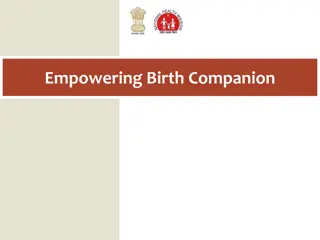Types of Birth Control Methods and Their Effectiveness
Explore the different types of birth control available, including abstinence, hormonal methods, barrier methods, and permanent methods. Learn about the effectiveness rates, how they work, and their pros and cons to make an informed decision about contraception. From hormonal options like pills, patches, and injections to barrier methods like condoms and diaphragms, understanding your choices is key to finding the right birth control method for you.
Download Presentation

Please find below an Image/Link to download the presentation.
The content on the website is provided AS IS for your information and personal use only. It may not be sold, licensed, or shared on other websites without obtaining consent from the author. Download presentation by click this link. If you encounter any issues during the download, it is possible that the publisher has removed the file from their server.
E N D
Presentation Transcript
CONTRACEPTION What types of Birth Control are available to me?
TYPES OF CONTRACEPTION ABSTINENCE HORMONAL METHODS BARRIER METHODS PERMANENT METHODS
ABSTINENCE 0% Failure Rate Complete Protection from STI s Always available Always used correctly FREE!
HORMONAL METHODS Releases Progestin and sometimes estrogen into the system. Keeps eggs from leaving the ovaries. Makes a woman's cervical mucus thicker. This keeps sperm from getting to the eggs. Many different forms: Pill- 9 out of 100 effectiveness Implant- 1 out of 100 effectiveness Patch- 9 out of 100 effectiveness Shot- 6 out of 100 effectiveness Ring- 9 out of 100 effectiveness IUD- Less than 1 out of 100 effectiveness
BIRTH CONTROL PILLS 1-2% Failure Rate No Protection against STI s Prescription Use Only Must be taken daily
PATCH 1-2% Failure Rate No Protection against STI s Prescription Use Only New patch must be applied every week
THE RING 1-2% Failure Rate No Protection against STI s Prescription Use Only New Ring Inserted Each Month
INJECTION <1% Failure Rate No Protection against STI s Prescription Use Only One injection every three months
BARRIER METHODS Collects pre-ejaculation and semen when a man ejaculates. Keeps sperm from entering the vagina. Also prevents transmission of most STI s and STD s. Many different forms: Sponge- 12 out of 100 effectiveness if no children. 24/100 if yes. Cervical Cap- 29 out of 100 effectiveness Male Condom- 18 out of 100 effectiveness Female Condom- 21 out of 100 effectiveness Diaphragm- 12 out of 100 effectiveness
MALE CONDOM 11% Failure Rate Offers good protection against STI s Available over the counter Applied immediately before intercourse, used once Cost is inexpensive
FEMALE CONDOM 21% Failure Rate Limited protection against STI s Available over the counter Inserted before intercourse, used once Inexpensive, but more expensive than male condom.
DIAPHRAGM plus SPERMICIDE 17% Failure Rate No protection against STI s Prescription Use Only Must be left in place for 6 hours after intercourse; can be washed and reused
CERVICAL CAP plus SPERMICIDE 17-23% Failure Rate No Protection against STI s Prescription use only Proper insertion can be difficult; must be left in place for 8 hours after intercourse; can be washed in reused
SHIELD plus SPERMICIDE 15% Failure Rate No Protection against STI s Prescription use only Must be left in place for 8 hours after intercourse; can be washed and reused shield
SPONGE 16% Failure rate No protection against STI s Over the Counter Must be left in place for 6 hours after intercourse; discarded after use
SPERMICIDE ALONE 35% Failure Rate No Protection against STI s Over the Counter Varies based on type
PERMANENT METHODS VASECTOMY: Male s vas deferens are cut to not allow sperm to reach semen TUBAL LIGATION: tubes are cut and tied to prevent egg from reaching the uterus. Less than 1 out of every 100 women get pregnant. No protection against STI s Medical Procedure One time Procedure.
VASECTOMY, TUBAL LIGATION <1% Failure Rate No protection against STI s Medical Procedure One time Procedure. VASECTOMY: Male s vas deferens are cut to not allow sperm to reach semen. TUBAL LIGATION: tubes are cut and tied to prevent egg from reaching the uterus.
UNRELIABLE METHODS DO NOT EVER USE!
FAM: Fertility Awareness Method Obstaining from intercourse during the days of the female s cycle where she is most likely to get pregnant.
WITHDRAWAL METHOD 53% Failure Rate No protection against STI s TERRIBLE method of birth control. NOT FOR TEENS!

 undefined
undefined




























